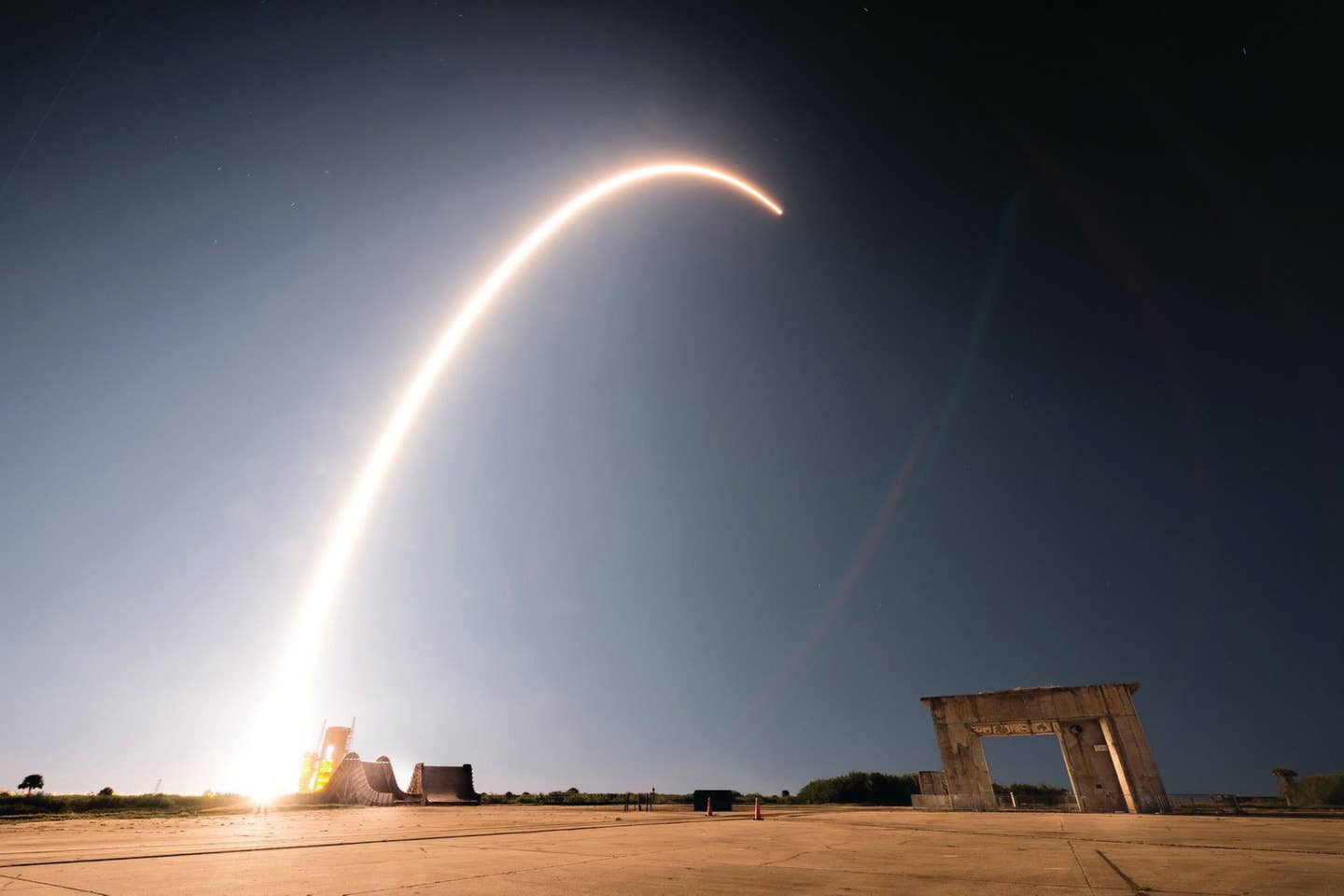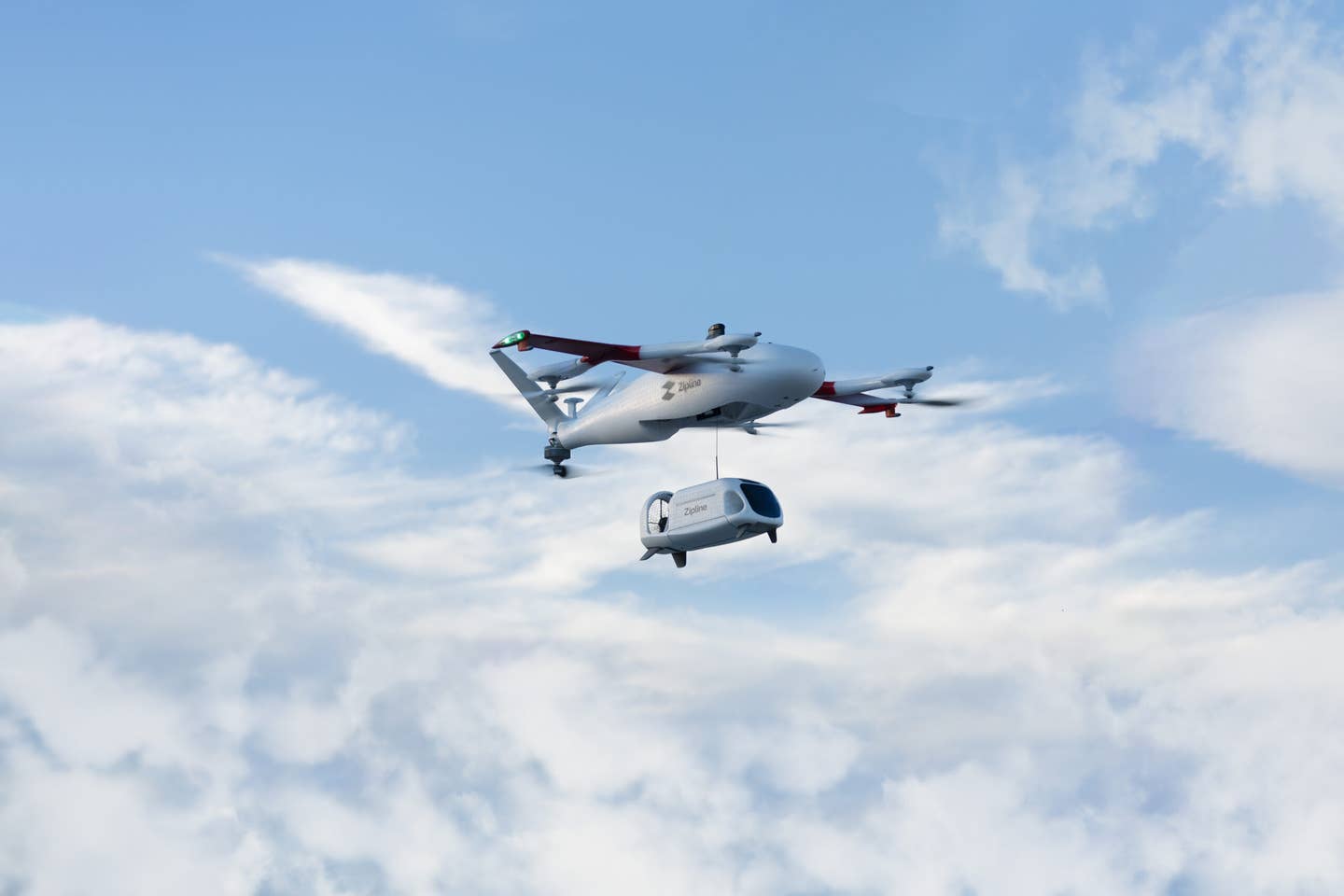To Infinity and Beyond
The U.S. Space Force takes on the new frontier of national security.

A Falcon 9 rocket launches on Jan. 6, 2020, at Cape Canaveral Air Force Station. The rocket, carrying an installment of Starlink satellites, was the first official launch of the United States Space Force. [U.S. Air Force photo by Joshua Conti]
The U.S. Space Force (USSF)—the nation’s newest military service branch and the first created in a generation—stands ready to engage in a new era of national defense where commercial space and military interests collide.
Pushing military capabilities “to infinity and be-yond” isn’t exactly new. The U.S. military began space research following World War II and prior to the formation of the Department of the Air Force. Nearly four decades later, the U.S. Air Force (USAF) unified efforts by establishing the Air Force Space Command in 1982. That mission later expanded into cyberspace as well as providing space-based communication and navigational support for U.S. forces deployed in Iraq and Afghanistan.
In December 2019, the command was authorized to stand alone when Congress gave the green light to the creation of the new service through the National Defense Authorization Act. When it was signed into law, it marked the reality that space creates a new frontier when it comes to national security. The need for a new service focused on defense in space comes as adversaries, such as China, increasingly modernize their military capabilities. U.S. military leadership keeps a wary eye on China’s growing inventory of hypersonic weapons, anti-satellite systems and cyber and electronic warfare capabilities. “While America is still the dominant military power on the planet today, we are being more effectively challenged militarily than at any—any—other time in our history,” Secretary of the Air Force Frank Kendall said at the Air Space Cyber Conference in September 2021.
That challenge is no longer strictly terrestrial. In an era of commercial space tourism and satellite dependence, space has gone from a benign environment to a contested one, according to one top Space Force official.
“We don’t have decades. We’re in a race with some serious adversaries that mean to deny us those advantages that we get in space,” says Lt. General B. Chance Saltzman, USSF deputy chief of space operations. Russia and China are pursuing and using kinetic and non-kinetic space weapons, “some operating on the ground, pointing up. And some that are designed to work from orbit,” Saltzman says. Some of those systems include directed energy, jammers, and satellite kill vehicles, he says.
In addition, there are currently nearly 30,000 tracked space debris objects in orbit, prompting the monitoring of more than 1,500 that have the potential for collision at any given time, he adds. “Space has truly become a congested and contested environment,” Saltzman says.
Built for Speed
The Department of the Air Force’s Space Force, which currently has nearly 7,000 uniform-wearing guardians, is a coequal branch of service alongside the USAF. It consists of a simplified structure of three field com-mands: Space Operations Command (SpOC), Space Systems Command (SSC) and Space Training and Readiness Command (STARCOM).
With a streamlined headcount of personnel expected to grow to 8,400 in the coming fiscal year, standing up the new service has been an exercise in building some-thing new while also culling layers of bureaucracy, says General John W. “Jay” Raymond, USSF chief of space operations. “We wanted to have a purpose-built organization, built for speed. Something that could go fast. Something where we can push decision making down to the lowest level, and something that we could get layers of bureaucracy out of the way,” Raymond says.
The USSF’s focus on speed means senior leadership infield commands will have more authority and resource sat their disposal. “SSC needs to re-energize its approach to seeing, understanding, and rapidly developing while fielding new capabilities to keep us ahead of threats that we see from China and others,” says USSF Vice Chief of Space Operations General David D. Thompson.
Picking up the pace means that the Space Force will also need to expand partnerships when it comes to acquisitions, Thompson says. “Commercial companies are moving so rapidly. We need to develop partnerships with the commercial sector to understand what they are doing as well as be able to leverage it to our benefit.”
New Service, New Look
In addition to setting the command structure, the Department of the Air Force codified the USSF’s official military doctrine, outlining the theory of independent space power. It also approved the official seals, motto (“Semper Supra,” translation: “Always Above”) and flags.
The service has also selected prototypes of its dress uniform and training gear. The new Space Force dress uniform takes a nod from the Air Force’s uniform, with grey dress slacks, but features a distinctive dark navy blue asymmetrical jacket reminiscent of the dress uniforms from the sci-fi drama Battlestar Galactica with six silver buttons descending in a line from the right shoulder. The buttons represent the six branches of the U.S. military. The USSF running shorts are emblazoned with a Star Trek-esque delta emblem at the hemline.
In September 2021, the Space Force released the design of its enlisted rank insignia, which incorporates a similar delta symbol enclosed within a six-sided border. Almost immediately, comparisons were made to the insignias worn by Star Trek characters, accusing the new service of ripping off a design element from a beloved TV show. But that was far from the case, according to William Shatner, who portrayed Captain James T. Kirk in the science fiction series. “‘Star Trek’ has borrowed so much of its iconic rank symbols from the U.S. military and NASA,” Shatner wrote in a Military Times op-ed piece in August.
The delta symbol is a solid nod to the U.S. military’s space past. “The delta symbol, the central design element in the seal, was first used as early as 1942 by the U.S. Army Air Forces; and was used in early Air Force space organization emblems dating back to 1961,” states a USSF news release in announcing the design. “Since then, the delta symbol has been a prominent feature in military space community emblems.
Editor's Note: This article originally appeared in the Q1 2022 issue of FLYING Magazine.

Sign-up for newsletters & special offers!
Get the latest FLYING stories & special offers delivered directly to your inbox






